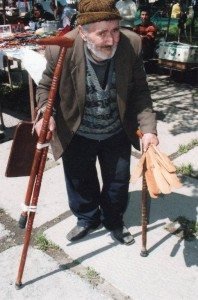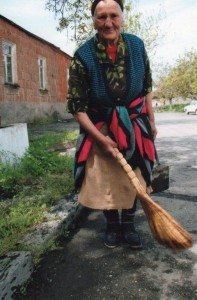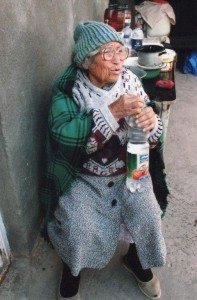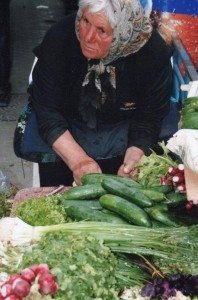On a dirt road in Geghard—one of many found in Armenia—an elderly woman sweeps the street with a broom more suitable for a pygmy. She looks up, smiles amiably, then goes about her business.

The road won’t get any cleaner than it is, but the woman sweeps anyway as if she were obligated or obliged.
In Armenian, she tells us, “It’s always been my custom to keep a tidy home and that includes the street. Would you like to come inside and join me for a cup of coffee?”
To refuse such an invitation would have been discourteous. To accept would have meant an idle hour or two of hospitality.
We accepted. And the coffee came with bread, cheese, dried beef, and fruit.
At Vernissage, an open-air flea market that comes to life like a Brigadoon, a man on crutches dressed for winter straddles along in 60-degree weather peddling his wooden bookmarks. There are vendors here who remain situated, and others like wandering minstrels with wares in hand.
He claims to have made them himself and offers one to any taker. A token of appreciation was expected. Otherwise, you’re in for a culture shock. Others will harp on the scene, begging your generosity, almost in cahoots with the guy.
How could you turn an 80-year-old down, even if you didn’t need the trinket?

In Jermuk, you can find all the water you want. That’s where it’s bottled in a refinery and distributed throughout the land. A woman with a colorful stocking hat over her head pitches you a container, with a twist. Hers are a tad cheaper than what you’d find in the store.
She has cups on a table inviting you to try a sample.
Sample water?
“You come to Jermuk, the water is better than anywhere else because it’s straight from the spring to your mouth,” she explains.
At the farmer’s market in Yerevan, the elderly are found pitching their vegetables and fruits, all of it homegrown. They come here like a sorority and beckon the same clientele with the power of appeal. It’s all in neat array waiting to test your appetite.
Go to a dozen villages on tour and invariably you’ll find a roadside vendor hawking everything from bread and lavash to embroidery, wine, fruits, cheeses, sujuk, and bastegh. Musicians have their places. One senior was renting out doves at Khor Virap for a price.
“It’s the bird of peace,” he told us. “You bring it to the vank, let it fly, and God will be with you.”

We were later pleased to discover that they were more like homing pigeons and returned to the site from which they were released.
A number of elderly were found digging and planting at the Armenian Tree Project, feeling connected to the earth, while others were seen with their hands extended, hoping for some mercy. It was more the exception than the rule.
At Oshakan, an octogenarian greeted us at the door with candles and other religious artifacts on his table. He was quick to tell us this was the burial place of Sourp Mesrob Mashdots, who created the Armenian alphabet, and there were symbols of his life throughout the property.
Another gatekeeper his age was found outside a dilapidated church in Ptghni, accompanied by a cow. He’s been coming here each day to lend spirituality to visitors who might amble by. His quarters are outdoors by rocks where a self-made shrine is all the inspiration he needs. Rain and cold are no deterrents.
According to reports, Armenia has a rapidly aging population. About 15 percent of the country’s population is already over 60. Fertility decline, along with the migration of an economically and reproductively active population, contribute to the numbers.

Projections further indicate that by 2050, almost 31.5 percent of Armenia’s population will be considered elderly, which may imply a significant added burden to the state.
The report also embraces the concept of active aging, remaining close to one’s environment and family while keeping the body and mind nimble.
In Ambert, an elderly woman with a pig on a leash greeted us by the fortress. The mountains were her home and the pig had a name. Satenik.
Not far was a woman selling pomegranates. The natural fruit of Armenia.
“Eat these,” she said, “and you’ll live to be healthy. You’ll live to a ripe old age.”


Dear Tom,
I really enjoyed reading you article, especially from ordinary healthy elderly ladies, with their livestock, spring water and their ripe old age secrets!